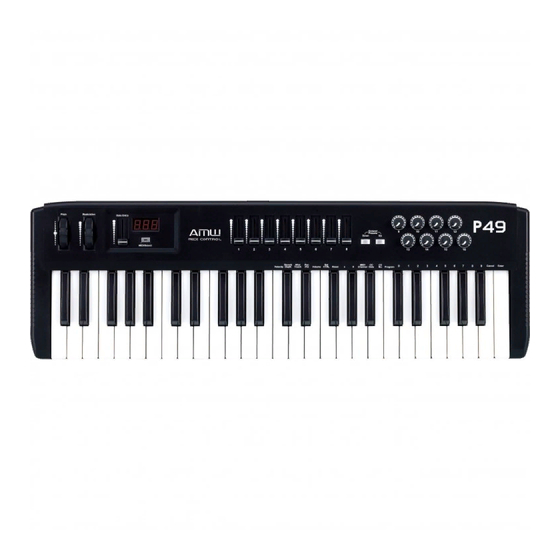
Table of Contents
Advertisement
Advertisement
Table of Contents

Summary of Contents for AMW P49
-
Page 2: Preface
This manual is written to help you become familiar with the powerful features of the AMW P49. Please read the manual carefully to discover all the features of your AMW P49 after reading the manual, you will have a clear understanding of how to transmit different MIDI messages to other instruments and equipment. -
Page 3: Table Of Contents
SOMETHING YOU SHOULD KNOW BEFORE USING THE MIDI FUNCTIONS --------------------------------------------------------- 4 USING THE MIDI FUNCTIONS --------------------------------------- 5 USING THE MIDI-INTERFACE --------------------------------------- 6 DEFAULT SETTING OF THE AMW P49 --------------------------------- 7 OVERALL DIAGRAM PREVIEW ------------------------------------- 8 PITCH BEND WHEEL ---------------------------------------------------- 8 MODULATION WHEEL ------------------------------------------------- 8... -
Page 4: Importand Secure Information
IMPORTAND SECURE INFORMATION Please read the following secure instructions first! Very Important!! 1. Never use the keyboard in the near of water like a swimming pool, bathtub or wet environment like a basement or in rain or similar. 2. Never use the keyboard in the near of heating elements like a radiator or similar, also high temperatures or direct sunbeam should be avoid. -
Page 5: Main Feature
6 x AA size battery for portability. To set up the MIDI connection of your AMW P49 to your PC’s sound card, your AMW P49 comes with an USB cable. This cable connects your AMW P49 keyboard to your PC USB- port, which makes it simple to expand your system. -
Page 6: Using The Midi Functions
To transmit MIDI data from your keyboard to other professional MIDI instruments, please purchase a MIDI cable and use it to connect the MIDI OUT jack of your AMW P49 to the MIDI IN jack of the other instrument. Make sure that the MIDI "transmit" channel on your AMW P49 matches the MIDI "receive"... -
Page 7: Using The Midi-Interface
Using the Midi-Interface The Minicontrol-2 Keyboard has a build in midi-interface; witch transfers the midi data from the keyboard to the computer, but also from the computer to the midi-out at the keyboard. The booth midi-outs are separate usable, to control a sound expander or maybe an effect device. -
Page 8: Default Setting Of The Amw P49
Default Setting of the AMW P49 The AMW P49 will always select the following values for their parameters when the power is turned on. *Transmit MIDI Channel no. 1. *Default Octave will be from C2 (36) to C4 (62) *Default After Touch value will be 0... -
Page 9: Overall Diagram Preview
Overall Diagram Preview Operation panel: Pitch Bend Wheel The Pitch Bend wheel is used for raising or lowering the pitch of a voice during performance. The range of pitch values depends on the sound generator (sound card or module) being used. Please refer to the manuals of your devices for information on how to change the Pitch Bend range. -
Page 10: Data Entry Slide
MIDI instruments to their default setting as well. Control Change data entry by Numeric keypad AMW P49 allows you to use the numeric keys to specify your Control Change DATA parameter instead of data entry slide. By pressing MIDI/SELECT button and CC data key & then the... - Page 11 required number and finally the Enter key to finish. For example, if you want to make Control Change 7 as value 123. 1) Press MIDI/SELECT button; 2) Press CC No. (will be shown in display) 3) Choose 7 on numeric keypad; 4) Press enter key to specify Control Change as 7;...
-
Page 12: Program Key
Program key Pressing MIDI/SELECT button and the Program key, then numeric keys then enter key, you can select any patch number between 1 to 128. For example, if you want to change voice to 67 (Tenor Sax): Press MIDI/SELECT button and 67 on numeric keys, then enter key and MIDI/SELECT button again to finish this action. -
Page 13: Rear Panel
Rear Panel Sustain jack This jack allows you to connect an optional Sustain Footswitch to the keyboard. MIDI OUT jacks This standard MIDI jacks is used to send MIDI messages to another MIDI instrument (such as sound module). USB Port / power port This jack is used to connect the keyboard with the computer, to get power and send MIDI messages directly to the sound card. -
Page 14: Trouble Shooting
There are some misunderstandings, because a midi device is not recognizable by computer, except USB. The midi standard does not support recognizing of devices! The AMW P49 is recognized by USB but not by midi-interface, this is normal!! Pedal doesn’t work . . . - Page 15 USB doesn’t work . . . Is power switch on power-on position? Are you sure that the computer found the keyboard or an unknown USB-Device? In the first case everything is Ok. In the second case there is a problem of the Hardware of the keyboard.
- Page 16 Admin or User mode . . . Are you Admin or User on this computer system? In User mode are some restrictions for USB devices, so many devices do not work in this mode. Power supply does not work . . . If the unit isn’t powered by power-supply, try to connect by USB-Connection.
-
Page 17: Specifications
Specifications AMW P49 Model: Keyboard 49 dynamic keys. Simultaneous Note output 20 notes (Reverse priority) MIDI Channel Reset Transpose -,+ Program Change CC-No.(Generic CC Assignment) CC-Data Control switches Data Entry Velocity Assignment, Data Entry Reverb Send Level Assignment, Data Entry Chorus Send Level Assignment,... -
Page 18: Midi Implementation Chart
MIDI Implementation Chart AMW P49 Model: Function Transmitted Recognised Remarks Basic Channel Default Changed 1-16 Mode Default Mode 3 Messages ************* Altered Note Number : 12-108 With Octave Change True Voice ************* Velocity Note ON Note OFF After Key's Touch...
Need help?
Do you have a question about the P49 and is the answer not in the manual?
Questions and answers